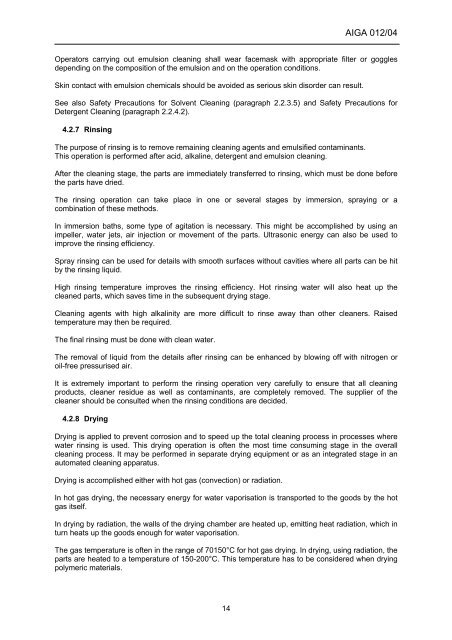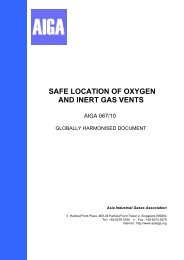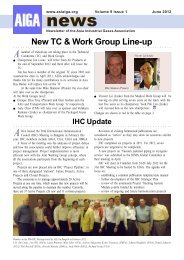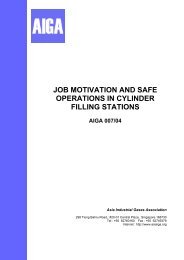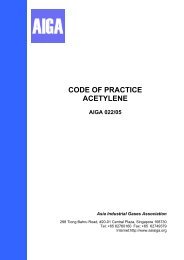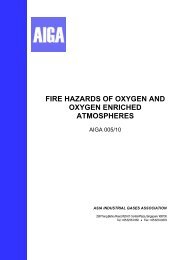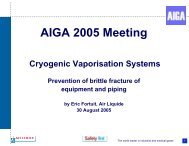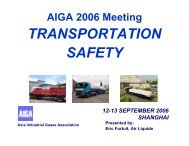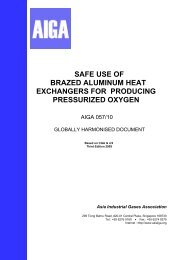CLEANING OF EQUIPMENT FOR OXYGEN SERVICE - AIGA
CLEANING OF EQUIPMENT FOR OXYGEN SERVICE - AIGA
CLEANING OF EQUIPMENT FOR OXYGEN SERVICE - AIGA
You also want an ePaper? Increase the reach of your titles
YUMPU automatically turns print PDFs into web optimized ePapers that Google loves.
14<br />
<strong>AIGA</strong> 012/04<br />
Operators carrying out emulsion cleaning shall wear facemask with appropriate filter or goggles<br />
depending on the composition of the emulsion and on the operation conditions.<br />
Skin contact with emulsion chemicals should be avoided as serious skin disorder can result.<br />
See also Safety Precautions for Solvent Cleaning (paragraph 2.2.3.5) and Safety Precautions for<br />
Detergent Cleaning (paragraph 2.2.4.2).<br />
4.2.7 Rinsing<br />
The purpose of rinsing is to remove remaining cleaning agents and emulsified contaminants.<br />
This operation is performed after acid, alkaline, detergent and emulsion cleaning.<br />
After the cleaning stage, the parts are immediately transferred to rinsing, which must be done before<br />
the parts have dried.<br />
The rinsing operation can take place in one or several stages by immersion, spraying or a<br />
combination of these methods.<br />
In immersion baths, some type of agitation is necessary. This might be accomplished by using an<br />
impeller, water jets, air injection or movement of the parts. Ultrasonic energy can also be used to<br />
improve the rinsing efficiency.<br />
Spray rinsing can be used for details with smooth surfaces without cavities where all parts can be hit<br />
by the rinsing liquid.<br />
High rinsing temperature improves the rinsing efficiency. Hot rinsing water will also heat up the<br />
cleaned parts, which saves time in the subsequent drying stage.<br />
Cleaning agents with high alkalinity are more difficult to rinse away than other cleaners. Raised<br />
temperature may then be required.<br />
The final rinsing must be done with clean water.<br />
The removal of liquid from the details after rinsing can be enhanced by blowing off with nitrogen or<br />
oil-free pressurised air.<br />
It is extremely important to perform the rinsing operation very carefully to ensure that all cleaning<br />
products, cleaner residue as well as contaminants, are completely removed. The supplier of the<br />
cleaner should be consulted when the rinsing conditions are decided.<br />
4.2.8 Drying<br />
Drying is applied to prevent corrosion and to speed up the total cleaning process in processes where<br />
water rinsing is used. This drying operation is often the most time consuming stage in the overall<br />
cleaning process. It may be performed in separate drying equipment or as an integrated stage in an<br />
automated cleaning apparatus.<br />
Drying is accomplished either with hot gas (convection) or radiation.<br />
In hot gas drying, the necessary energy for water vaporisation is transported to the goods by the hot<br />
gas itself.<br />
In drying by radiation, the walls of the drying chamber are heated up, emitting heat radiation, which in<br />
turn heats up the goods enough for water vaporisation.<br />
The gas temperature is often in the range of 70150°C for hot gas drying. In drying, using radiation, the<br />
parts are heated to a temperature of 150-200°C. This temperature has to be considered when drying<br />
polymeric materials.


